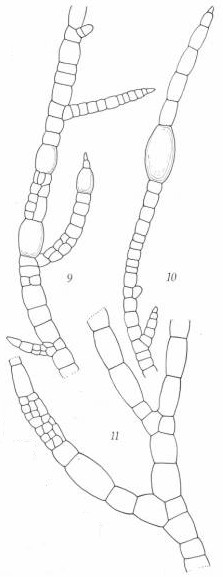Biology:Zosterocarpus abyssicola
| Zosterocarpus abyssicola | |
|---|---|

| |
| Fig. 9, part of a branch showing the branchlets, young tannin-filled cells, and early gametangium development. Fig. 10, branch tip showing the acute apex, the intercalary growth zones, and a yellow tannin-filled cell. Fig. 11, junctions of the forks of two larger branches and a well-developed gametangial area | |
| Scientific classification | |
| Domain: | Eukaryota |
| Clade: | Diaphoretickes |
| Clade: | SAR |
| Clade: | Stramenopiles |
| Phylum: | Gyrista |
| Subphylum: | Ochrophytina |
| Class: | Phaeophyceae |
| Order: | Ectocarpales |
| Family: | Chordariaceae |
| Genus: | Zosterocarpus |
| Species: | Z. abyssicola
|
| Binomial name | |
| Zosterocarpus abyssicola W.R.Taylor, 1945
| |
| Synonyms | |
| |
Zosterocarpus abyssicola is a species of brown algae endemic to the Galapagos islands.
Distribution
This is a very inconspicuous species and hard to identify, so much that it is only known from its collection of types.[1] The only specimens were collected in 1934 at Post Office Bay by Floreana Island in the Galápagos Islands, and the species is considered endemic to the area.[2] A 2007 search failed to find any further specimens.[1]
Etymology
The specific epithet abyssicola derives from the Greek ἄβυσσος (ávyssos) and Latin -cola, meaning one who inhabits the abyss. However, it has only been found at 55 meters depth,[2] and is photosynthetic, so the name is hyperbole.
Description
The thallus is a light green-brown and 1-2 cm tall.[2] The form is rather diffuse and spreading, without a persistent main axis.[2] The cells of the major branches are thin-walled, cylindrical, and 32 μm in diameter and 58-65 μm long.[2]
The characteristic oval brown cells were assumed to be the sporangia by Taylor,[2] but are special tannin-filled cells.[3] These are scattered throughout the upper thallus, but solitary, measuring about 30 μm in diameter and 68-70 μm long.[2] They contain oval-shaped bodies.[2]
The gametangia are in clusters of 4-6 cells and only 6-8 μm in diameter.[2]
The species lacks phaeophycean "hairs" and the parenchyma is weakly developed.[3] It is more slender than Z. oedogonium, and the brown tannin cells for the former are wider than the rest of the filaments, ad opposed to the same size.[2] Z. ogasawaraensis and Z. australicus lack these special cells.[3] The latter two also have laterals that arise from single sells on the filaments and not from the septa between cells like the former two species.[3]
Ecology
The species is an epiphyte.[2] It is thought to be eaten by sea urchins.[1]
Conservation
It has been evaluated by the IUCN as data deficient, and is one of only fifteen protists evaluated by IUCN.[1] Like Desmarestia tropica, another William Randolph Taylor find from the same expedition, it is threatened by warming ocean temperatures and overgrazing by sea urchins.[1]
References
- ↑ Jump up to: 1.0 1.1 1.2 1.3 1.4 1.5 Miller, K.A.; Garske, L.; Edgar, G. (2007). "Zosterocarpus abyssicola". IUCN Red List of Threatened Species 2007: e.T63592A12685875. doi:10.2305/IUCN.UK.2007.RLTS.T63592A12685875.en. https://www.iucnredlist.org/species/63592/12685875. Retrieved 13 November 2021.
- ↑ Jump up to: 2.00 2.01 2.02 2.03 2.04 2.05 2.06 2.07 2.08 2.09 2.10 2.11 Taylor, William Randolph (May 1945). "Pacific marine Algae of the Allan Hancock expeditions to the Galapagos islands" (in en) (TIF). Allen Hancock Pacific Expeditions 12: 79–80,320–321. OCLC 758261137. http://digitallibrary.usc.edu/cdm/ref/collection/p15799coll82/id/22233. Retrieved 16 August 2018.
- ↑ Jump up to: 3.0 3.1 3.2 3.3 Kitayama, Taiju (22 November 2013). "Morphology of Zosterocarpus ogasawaraensis sp. nov. (Phaeophyceae, Ochrophyta), a New Marine Deep-water Brown Alga from the Ogasawara Islands, Japan" (in en). Bulletin of the National Museum of Nature and Science 39 (4): 159–164. ISSN 1881-9060. OCLC 5528941544. http://www.kahaku.go.jp/english/research/researcher/papers/232947.pdf. Retrieved 16 August 2018.
External links
Wikidata ☰ Q18745945 entry
 |


